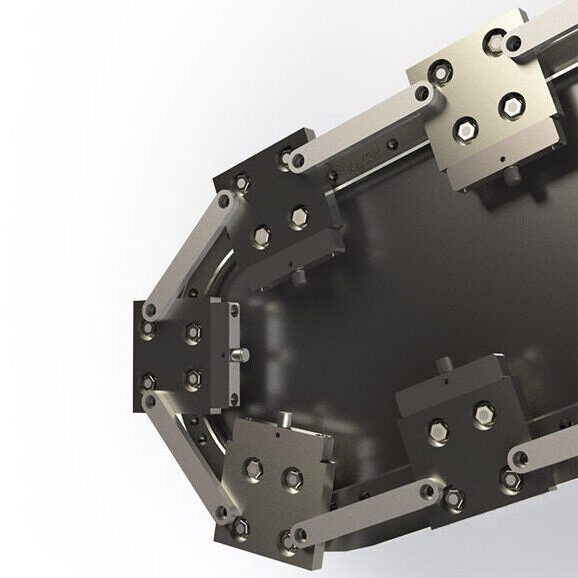I. Taper and turning radius: why is the formula not valid for actual working conditions?
central contradiction: Theoretical formulaeR = D/k + c(R: turning radius; D: diameter of the small end of the roller shaft; k: taper; c: inner clearance) in the application of the 10%-30% error often occurs. The root cause is not consideredcentrifugal force of cargo inertiatogether withRoll surface friction coefficient dynamics.
Case Comparison: A car assembly line, according to the theoretical calculation of the choice of taper 1/50 (k = 0.02), the turning radius is designed for 1200mm. the actual operation of the box on the outside of the curve offset up to 50mm. after testing found:
- Speed differential overrun: Theoretical linear speed difference 6.3%, measured up to 9.1% (due to motor speed fluctuation)
- Friction coefficient decay: Reduction of friction coefficient from 0.7 to 0.4 due to oil contamination on steel roll surface
II. Four-step approach to precision computing: from formula to landing parameters
Step 1: Basic parameter locking
| parameters | formula | Engineering Tips |
|---|---|---|
| Taper k | k = (D large - D small)/L | When the conveying speed>1m/s, k is taken as1/30 to 1/50 |
| Turning radius R | R ≥ 1.2 x L (L: cargo length) | Long goods (L>1500mm) need to x 1.5 safety factor |
ask and answer questions for oneself: Is the taper taken 1/30 or 1/50?
reply: Low-speed light load (1m/s) choose 1/50 - the smaller the taper the stronger the resistance to deflection, but the cost increases 35%.
Step 2: Dynamic Velocity Difference Compensation
Key formula::
Δv/v=tanθ≈θ(θ: cone angle in radians)
control strategy::
- normal working condition: Limit Δv/v ≤ 6.3% (corresponding to a 3.6° cone angle)
- Precision Scene: AdoptionDouble cone angle roller set(e.g. outer roll 4.1° + inner roll 3.6°), speed difference compressed to 3.8%
Step 3: Measured correction of friction coefficient
| surface treatment | Coefficient of friction in dry state | Decay rate under oil |
|---|---|---|
| Plain carbon steel | 0.5 to 0.7 | 40% to 60% |
| Laser Micrographics | 0.8 to 1.0 | ≤15% |
| Source: Measured coefficient of friction of roller conveyor |
Step 4: Turning Radius Verification Formula Upgrade
revised formula::
Rhonest=[D/k+c]+0.1v2/g⋅μ-1
(v: transport velocity; g: acceleration due to gravity; μ: coefficient of friction)
case (law)When v=1.2m/s, μ=0.6, theoretical R=1500mm → actual requirement1680mm
Third, the three major scene parameter comparison table: direct application without error
| take | Taper k | Roller taper angle θ | Velocity difference Δv/v | Turning radius R |
|---|---|---|---|---|
| Courier sorting (cartons) | 1/50 | 2.86° | 5% | ≥800mm |
| Automotive parts (metal boxes) | 1/60 | 3.0° | 4.2% | ≥1200mm |
| Chemical drum (PE material) | 1/40 | 3.58° | 6.3% | ≥1500mm |
| Note: Metal box scenarios in bold are high-frequency problem points |
IV. Guide to avoiding the pit: 5 real-world optimisation tips
- Taper Angle Tolerance Control: Machining taper angle error must be <±0.1°, otherwise the radius deviation is enlarged to ±8%.
- Long piece of anti-dumping: When L/R > 1.5, every 30° additionaldifferential roller(Velocity gradient 2% to 3%)
- Wet environment countermeasures: 304 stainless steel rollers + axial anti-slip pattern, stable coefficient of friction > 0.8
- Corrective testing method: Stickers at the entrance to the bendfluorescent tapeAlarm if offset > 2%R
- Maintenance Gold Parameter: Roller shafts must be replaced if wear results in a change in cone angle of >0.5°.
V. Future trends: intelligent taper systems
- Real-time cone adjustment: Piezoelectric ceramics micro-adjustment of roll surface curvature (response time <50ms)
- AI prediction model: Advance calculation of the optimal k-value by means of dimensional/centre-of-mass data of the goods.
- digital twin verification: Simulate 100,000 turns in a virtual environment and output safety boundary parameters
At the heart of precision computing lies not only the formula, but also theDynamic variable compensation--Converting "theoretical radius" to "safe radius" requires triple correction of speed, friction and load. When the design parameters are infinitely close to the real physical boundaries, the conveyor line can really achieve zero offset turning.













